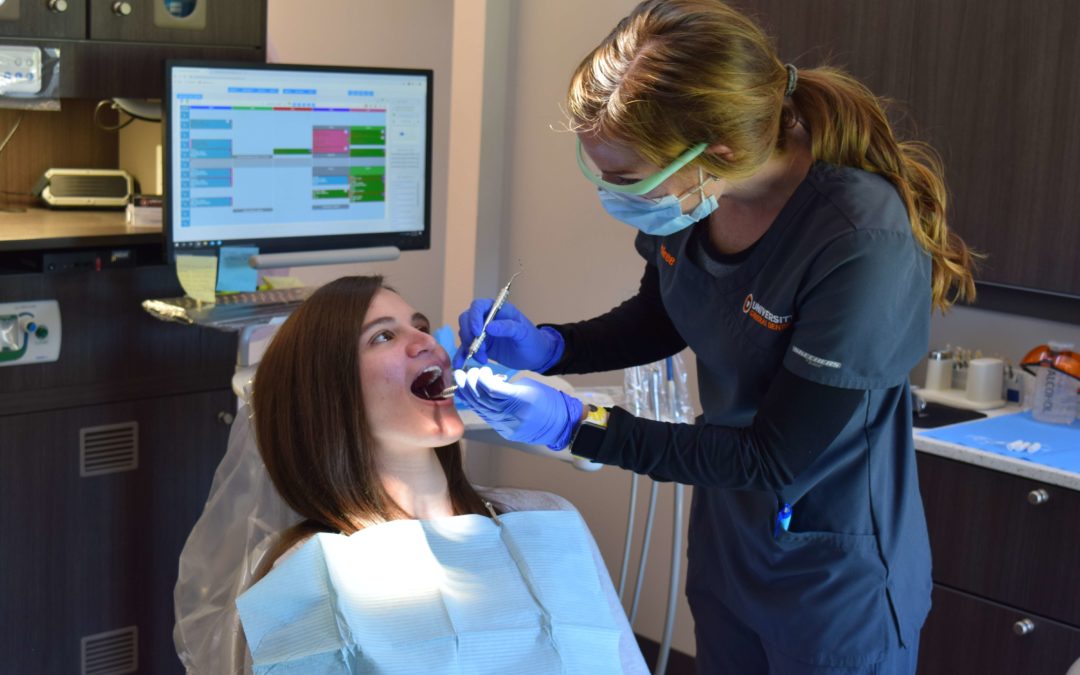When we think about regular dental visits, most patients anticipate a thorough cleaning, awkward conversation while the dentist has his tools in your mouth, and a little care package to take home, with a strict reminder to brush and floss. Do you ever wonder what the dentist is looking for—other than cavities—when they are in your mouth poking around? As with most other aspects of our preventative health, cancer screenings take place while in the dentist’s office as well. Oral cancer is a very broad term for any cancer in the mouth and the surrounding tissues, including lips, tongue, cheeks, hard and soft palate, sinuses, and the throat. Most of these areas are hard to see, so an extra set of expert eyes is the best detection for early signs of oral cancer.
Who Is Most at Risk for Oral Cancer?
While both men and women are at risk of developing oral cancer, according to the American Cancer Society, men are twice as likely to be diagnosed and are the greatest statistic over the age of 50. Race doesn’t seem to be a factor either, as both dark and light skinned people are equally at risk. One of the biggest risk factors is the history of inhaled tobacco use, as smokers are six times more likely to develop oral cancer than non-smokers. However, smokeless tobacco users are far from safe, as they are TWICE as likely to develop cancer of the gums, cheeks, and lip lining. Excessive drinking is also a contributing factor to cancer risk, as oral cancer is six times more common in drinkers than those that abstain from alcohol. There are also several of environmental factors, such as sun exposure, that heighten the risk. Carriers of certain HPV (human papillomavirus) strains are also on the list of higher risk to develop these types of cancers.
What Are the Symptoms?
It can be very easy to dismiss some of the earliest signs of oral cancer as minor dental issues or other minor health concerns. The most common early warning sign is a mouth sore that doesn’t want to heal, usually also connected with lingering mouth pain. Sometimes patients will find a lump or thickened area in the cheek that they dismiss as a wound from biting their cheek. White or red patches on the gums, tongue, tonsil, or lining of the mouth is a big red flag, along with numbness or swelling. Depending on the affected area, some affected also experience changes in voice, trouble chewing or swallowing, a sore throat or the feeling that something is caught and can’t be swallowed, trouble moving the jaw or tongue, a lump or mass in the neck, and constant bad breath. Because other serious health concerns could also cause many of these symptoms it’s important to see a doctor or dentist if any of these conditions last more than two weeks. Oral cancer can be life-threatening if not detected early. The American Cancer Society estimates that in 2019, about 53,000 people will be diagnosed for oral cancer, with an estimated twenty percent of these cases being terminal.
How Is Oral Cancer Diagnosed?
With most cases of oral cancer being diagnosed in a later stage, many experts agree that preventative screenings can be life-saving. One academic study found that when a dentist gave high-risk subjects (listed above) a visual exam it reduced the mortality rate by as much as thirty-four percent, compared with control patients who were not screened. Both the American Cancer Society and the American Dental Society recommend a regular visual exam during routine cleanings. Some dental practices include this screening at no additional cost during a regular exam, while others may charge a small fee, often covered by insurance. After a visual exam, most diagnostic procedures (if a suspicious spot is found) are done as a scalpel or laser biopsy. If the area in question is in the tonsil area or throat, and endoscopy may be recommended, along with imaging tests such as a CT scan.
What You Can Do to Prevent Oral Cancer
You can take an active role in preventative measures for oral cancer and detection, as well as your overall oral health! A few important things to remember:
- Do not smoke or use smokeless tobacco products such as chewing tobacco or snus.
- Drink alcoholic beverages in moderation (and don’t binge drink).
- Limit exposure to harmful UV and UVB rays. Sunscreen is always important, but don’t forget lip protection! Many chap-sticks now have SPF ratings.
- Eat a well-balanced diet and practice good oral care.
- Conduct a self -exam at least once a month, looking for changes in color, feel, and texture of your lips, cheeks, gums, and tongue. Call your dentist immediately if you notice any changes or symptoms listed above.
- See your dentist on a regular basis
Even if you’re being vigilant about checking yourself for any changes in your mouth, suspicious areas can be difficult to see on your own. That is why it is so important to schedule regular cleaning and check-ups with your dentist, even if you feel your oral health is fine and doesn’t need attention.
University General Dentists—Exceptional Care, Close to Home
When choosing a dentist, you look for education, skill, and a high level of care, which is exactly what we offer at University General Dentists—and more! Our team of highly-skilled professionals have access to the latest technology and evolving, modern dental research as a part of the University of Tennessee Medical Center, and we offer a personalized approach to your dental health. Whether it’s a wellness exam and cleaning, oral cancer screening, or reconstructive work, our dentists use their combined 75 years of experience to meet your needs and exceed your expectations. With two convenient Knoxville locations, we strive to offer the best dental care to the surrounding communities. Contact us today to schedule an appointment with one of our highly trained doctors.

